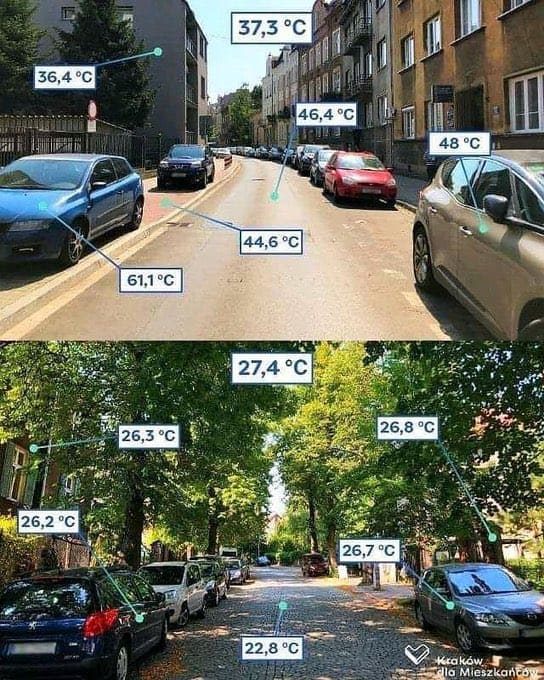How do we keep the urban environment cool as temperatures rise?
HEAT WAVES & EXTREME WEATHER EVENTS
Extreme heatwaves have become a defining feature of summers worldwide. As global temperatures continue to rise, they are becoming more frequent, intense, and prolonged (Source). According to an analysis by the World Weather Attribution, heatwaves are now 30% more likely due to climate change (Source). The existing “lack of heat protection” is already costing Germany billions of euros each year, according to Martin Herrmann, Chairman of the German Alliance for Climate Change and Health. Read more about heatwaves and hotspots in cities in our blog HERE.
These challenges necessitate adaptive responses. To address the growing health risks posed by extreme heat, the “Health Minister Conference of the States (GMK)” took a significant step in September 2020, pledging to foster comprehensive heat action plans in municipalities by 2025, as indicated by a source. At the national level, collaborative efforts with healthcare stakeholders are underway to develop a heat protection plan (Source).
While municipalities work on implementing the legal obligation to protect against heat in public spaces, additional difficulties and issues are emerging for businesses: Energy costs for conventional air conditioning and cooling systems are rising, as are the requirements for the working environment. Measures to enhance quality should be taken. These affect both general working conditions (e.g., in manufacturing facilities) and the design of recreational areas (e.g., in cafeteria areas). Such design also poses a challenge for another industry. The real estate sector must ensure that the appropriate compensatory and offset areas, as well as legal regulations, are considered in the design and implementation of projects to ensure the attractiveness of the property for users.
But there’s a ray of hope amid these challenges: Ready-made solutions are at hand. Consider urban greenery, for instance, which has the remarkable capacity to alleviate the consequences of global warming and urbanization, as substantiated by a reliable source. The concept of “expanding green infrastructure” and embracing urban green spaces stands out as arguably the most efficient and instinctive approach to curbing urban heat island effects and ensuring the well-being of local residents (Source).
Social media has recently witnessed a striking comparison between an urban area with abundant greenery and one without, with a focus on temperature measurements (Source: Only the Cook).
Naturally, we were compelled to delve into this comparison within the context of our diverse fresh air concepts. The reason being, our innovative approach harnesses the power of integrated specialized mosses, coupled with active ventilation, to deliver a substantial temperature reduction, thanks to their impressive evaporation capabilities.
THE COMPARISON: HOW EFFECTIVE ARE MOSS?
Surface temperatures of glass, traditional vegetation, and active moss mats.
We started our experiments and comparisons last summer, utilising a FLIR thermal imaging camera and integrated sensors installed on a CityTree situated in an outdoor setting in Bestensee, Brandenburg. Throughout the scorching summer months, we encountered multiple heatwaves, with temperatures soaring above 40°C. However, what caught our attention was the refreshing cool breeze consistently emanating from the moss filter.
Various measurements also confirmed significant temperature differences.
BEGINNING OF MEASUREMENTS IN 2022
In the summer of 2022, the actively operated moss biofilter mat had a thermal image temperature of 29°C, compared to 43.3°C in the immediate surroundings. The surface temperature of the moss module registered only 15°C.

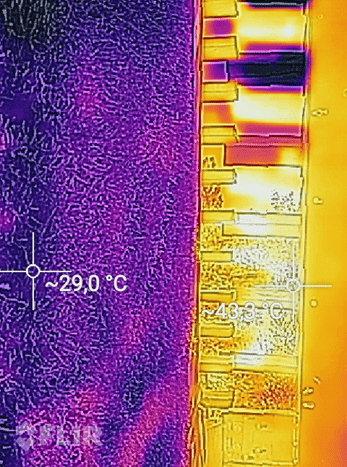
A comparison of the surface temperature of the nearby vegetation with the actively ventilated moss modules also yielded impressive results.
A measurement of 38.1°C for the vegetation (Thuja occidentalis) was contrasted with a temperature of only 23.8°C for the active moss mat (Bryophyta). A difference (ΔT) of 14.3°C! The results show that the moss surface of the CityTree remains “cool” at 24°C even with direct sunlight, while other vegetation (in the shade) heated up more.

Similar results were obtained in the surface temperature comparison for the adjacent shaded glass facade. The temperature here was 42.2°C, while the active moss mat recorded only 28.5°C, resulting in a difference (ΔT) of 13.7°C.
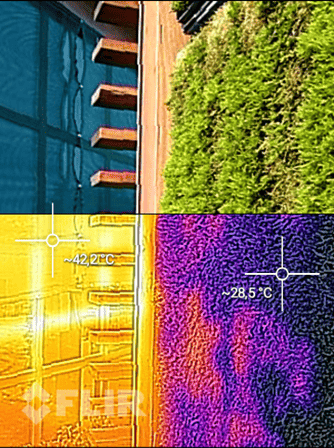
In the CityBreeze, Green meets Screen – and based on the integrated actively ventilated moss modules, it is the only DOOH column that cools its surroundings instead of heating them. The thermal imaging camera confirms this: While a temperature of 37.3°C was measured in the immediate vicinity, it was only 25.4°C on the moss wall.


The newest member of the fresh air zone family also provides us with clean and cool air in Bestensee: the WallBreeze not only enhances our office spaces visually but also ensures the best air quality. Thanks to the actively ventilated biological moss surface, the temperature difference (ΔT) is 9.8°C, creating a pleasant working atmosphere and quality of stay.
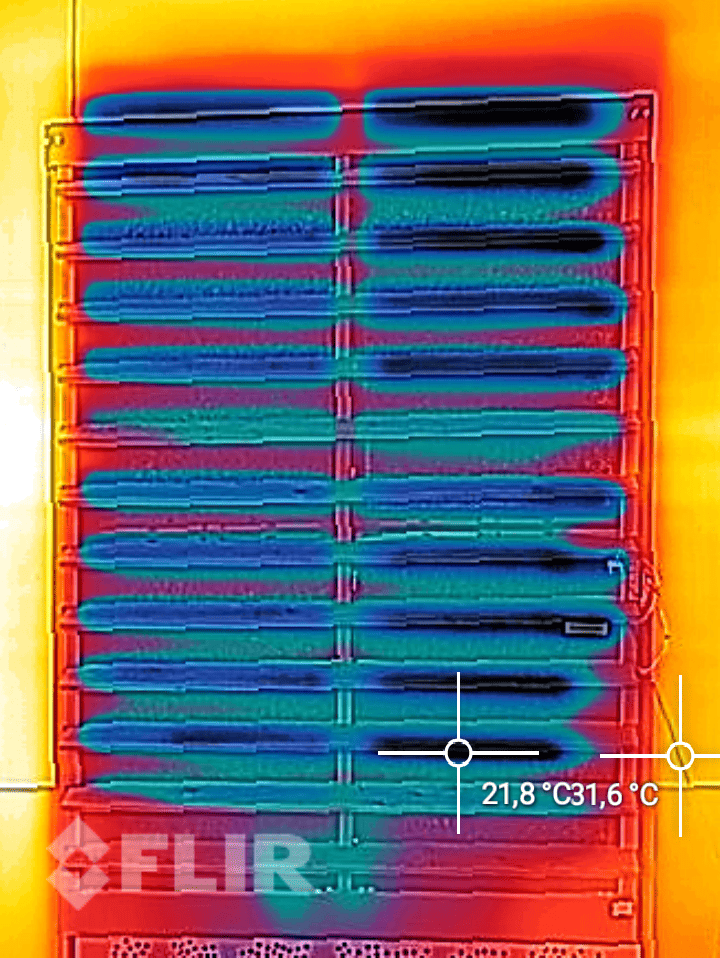
The comparison of the surface temperature of the outdoor CityTree in Bestensee with its immediate surroundings confirms the results from the previous year: A scorching 42.7°C ambient temperature contrasts with a pleasant 28.8°C on the moss modules!

STRESS TESTS IN EXTREME LOCATIONS – SOUTHERN ITALY
As part of a customer project in Southern Europe, we also employed a thermal imaging camera. Since June 2023, one of our CityTrees in Italy has been basking in the Mediterranean sun, offering us a fantastic chance to evaluate the effectiveness of the regenerative and intelligent moss filter in this scenic locale.
In conclusion, the impact of heatwaves and extreme temperatures is widespread, affecting our health, economy, and environment. However, innovative solutions like moss-based cooling systems, which emit 30% less heat at 35.9°C, offer hope. They not only combat rising temperatures but also improve air quality and enhance urban landscapes.
As we face climate challenges, exploring eco-friendly technologies is crucial. Together, we can create a cooler, more sustainable future. Stay tuned to our blog for more insights, and remember, the power to keep our world cool and comfortable is in our hands.

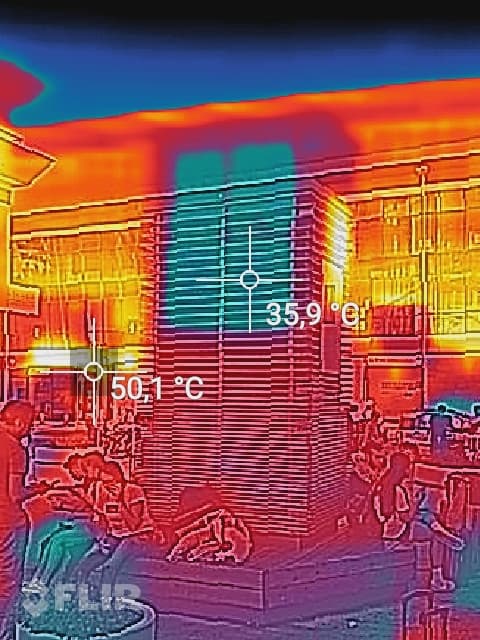
HITZEWELLEN & EXTREMWETTEREREIGNISSE
Extreme Hitzewellen sind mittlerweile ein prägendes Merkmal von Sommern weltweit. Da die globalen Temperaturen stetig steigen, werden sie außerdem immer häufiger, intensiver und länger anhaltend (Quelle). Gemäß einer Analyse der “World Weather Attribution” sind Hitzewellen aufgrund des Klimawandels nun um 30 % wahrscheinlicher (Quelle). Der existierende „Mangel an Hitzeschutz“ kostet Deutschland bereits Milliarden Euro pro Jahr, so Martin Herrmann, Vorsitzender von Deutsche Allianz Klimawandel und Gesundheit.
Mehr zu Hitze(wellen) und Hot Spots in Städten lest ihr HIER ins unserem Blog.
Die benannten Entwicklungen erfordern zusätzliche Anpassungen und stellen Herausforderungen dar. Um dem “Gesundheitsrisiko Hitze” entgegenzuwirken, hat “die Gesundheitsministerkonferenz der Länder (GMK) im September 2020 beschlossen, bis 2025 eine flächendeckende Erstellung von Hitzeaktionsplänen in Kommunen voranzutreiben” (Quelle). National soll ebenfalls zusammen mit “Beteiligten aus dem Gesundheitsbereich, darunter die Ärzteschaft und die Pflege aber auch Krankenkassen, Kommunen und Bundesländern” ein Hitzeschutzplan erarbeitet werden (Quelle).
Während die Kommunen an der Umsetzung der gesetzlichen Verpflichtung zum Schutz vor Hitze in der Öffentlichkeit arbeiten, kristallisieren sich für Unternehmen weitere Schwierigkeiten und Probleme hinsichtlich dessen heraus: Die Energiekosten für konventionelle Klimaanlagen und Kühlung steigen – genauso wie auch die Anforderungen an das Arbeitsumfeld. So sollten entsprechende qualitätssteigernde Maßnahmen unternommen werden. Diese betreffen sowohl allgemeine Arbeitsbedingungen (bspw. in Fertigungshallen) als auch die Gestaltung von Erholungsflächen (bspw. im Kantinen-Bereich). Eine solche Gestaltung erweist sich außerdem als Herausforderung für eine weitere Branche. Der Real Estate-Sektor muss dafür Sorge tragen, dass innerhalb des Entwurfs und der Realisierung von Projekten die entsprechenden Ausgleichs- und Kompensationsflächen sowie gesetzliche Vorschriften berücksichtigt werden, um gleichsam die Attraktivität der Immobilie für die Nutzer sicherzustellen.
Allerdings gibt es auch positive Nachrichten: Um diesen wachsenden Anforderungen gerecht zu werden, existieren bereits Lösungen. Städtisches Grün z.B: ist in der Lage, die Folgen der globalen Erwärmung und Urbanisierung abzumildern (Quelle). Eine “Ausweitung der grünen Infrastruktur“ und damit einhergehende städtische Grünflächen sind “vielleicht der effizienteste und intuitivste Weg, um städtische Wärmeinsel-Effekte zu reduzieren und Komfort für nahegelegene Bewohner zu bieten“ (Quelle).
In den sozialen Medien kursiert seit einiger Zeit der Vergleich eines urbanen Raumes – mit und ohne Begrünung – hinsichtlich der gemessenen Temperaturen (Quelle: Nurder Koch).
Dies wollten wir natürlich auch in Bezug auf unsere verschiedenen Frischluft-Konzepte überprüfen, denn die integrierten spezialisierten Moose können in Kombination mit aktiver Ventilation durch ihre hohe Verdunstungsleistung eine spürbare Temperaturreduktion erwirken.
DER VERGLEICH: WIE GUT SIND MOOSE WIRKLICH?
Oberflächentemperaturen von Glas, klassischer Vegetation & aktiven Moosmatten.
Bereits im Sommer vergangenen Jahres starteten wir mit einer FLIR-Wärmebildkamera, einem Infrarot-Thermometer und den integrierten Sensoren im CityTree erste Versuche und Vergleiche an einem CityTree im Outdoor-Bereich (in Bestensee/ Brandenburg). In den Sommermonaten trafen uns bereits einige Hitzewellen mit Temperaturen über 40°C, doch aus dem Moosfilter strömte – gut wahrnehmbar – immer eine angenehme kühle Brise.
Dies belegten auch diverse Messungen mit enormen Differenzen bezüglich der Temperaturen.
BEGINN DER MESSUNGEN IM JAHR 2022
Im Sommer 2022 verfügte die aktiv betriebene Moos-Biofiltermatte über eine Wärmebildtemperatur von 29 °C, die der unmittelbaren Umgebung betrug 43,3 °C.
Die Oberflächentemperatur des Moos-Moduls verzeichnete sogar lediglich einen Wert von 15 °C.


Ein Vergleich der Oberflächentemperatur der unmittelbar benachbarten Vegetation mit den aktiv ventilierten Moos-Modulen ergab ebenfalls beachtliche Resultate.
Einer Messung von 38,1 °C der Vegetation (Thuja occidentalis) stand einer Temperatur der aktiven Moosmatte (Bryophyta) von lediglich 23,8°C gegenüber. Eine Differenz (ΔT) von 14,3°C! Die gewonnenen Resultate lassen erkennen, dass die Moosoberfläche des CityTree trotz direkter Einstrahlung 24 °C “kühl” ist, während sich auch andere Vegetation (im Schatten) stärker aufheizte.
Ähnliche Ergebnisse zeigte der Oberflächentemperaturvergleich für die benachbarte Glasfassade mit Teilverschattung. Lag die Temperatur hier bei 42,2 °C, verzeichnete die aktive Moosmatte lediglich einen Wert von 28,5 °C, was einer Differenz (ΔT) von 13,7 °C gleichkommt.


Im CityBreeze trifft Green auf Screen – und auf Basis der integrierten aktiv ventilierten Moos-Module ist er die einzige DOOH-Stele, die ihre Umgebung abkühlt, anstatt sie aufzuheizen. Die Wärmebildkamera bestätigt dies: Während in der unmittelbaren Umgebung eine Temperatur von 37,3 °C gemessen werden konnte, betrug sie auf der Mooswand nur 25,4 °C.


Auch das neueste Mitglied der Frischluft-Zonen-Familie versorgt uns in Bestensee mit sauberer und kühler Luft: Der WallBreeze wertet unsere Büroräume nicht nur optisch auf, sondern versorgt sie auch mit bester Luftqualität. Der Temperaturunterschied (ΔT) beträgt dank der aktiv ventilierten biologischen Moosoberfläche 9,8 °C und verhilft so zu einer angenehmen Arbeitsatmosphäre und Aufenthaltsqualität.

Der erneute Vergleich der Oberflächentemperatur des Outdoor-CityTree in Bestensee mit seiner unmittelbaren Umgebung bestätigt die Resultate des Vorjahres: Drückende 42,7 °C Umgebungstemperatur stehen angenehmen 28,8 °C auf den Moos-Modulen gegenüber!

BELASTUNGSTEST AN EXTREMSTANDORTEN – SÜDITALIEN
Auch bei einem Kundenprojekt im Süden Europas kam die Wärmebildkamera zum Einsatz. Denn in Italien heißt es seit Juni 2023 “Buon Giorno da Bari!” für einen unserer CityTrees – eine willkommene Gelegenheit also, auch hier die Leistungsfähigkeit des regenerativen und intelligenten Moosfilters zu überprüfen.
Extreme Temperaturen, die Oberflächen auf über 50 °C aufheizen, sind eine Belastung für Menschen, für die Natur und Infrastruktur. Der gezielte Einsatz von Moosen, die mit 35,9 °C etwa 30% weniger Temperatur abstrahlen, kann also zu der notwendigen Entlastung führen.



